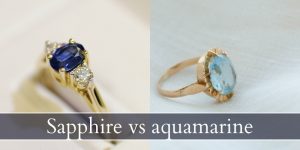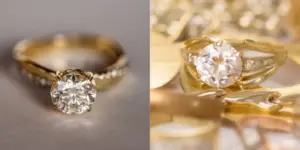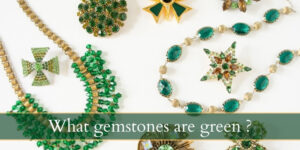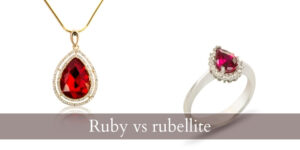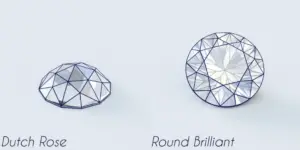Wondering if the Asscher cut diamond is the right one for you ? If you love step cuts, symmetry, and a lot of history then you may just love Asschers too. These are difficult to come by but they really are impressive. Read on to find out more about how this diamond cut came to be, what it should look like, and what you need to watch out for.
What is an Asscher cut diamond ?
Asscher diamonds are a type of step cut, in a rectangular shape with truncated corners, and facets leading down into the diamond. It looks very similar to a squared emerald cut, but differs in proportions and the culet is a single point instead of a thin line. Asschers are a relatively modern cut, invented in the very early 1900s, and is a rare find compared to other diamond cut, even other step cuts.
The name Asscher comes from the Asscher family, a very old family that founded the Royal Asscher Diamond Company. The diamond cut we know as Asscher today was invented in 1902 by Josaph Asscher, and patented. The patent expired during WWII, and many diamond cutters piggybacked on the original Asscher’s allure and produced their own Asscher diamonds, albeit with slight modifications and lesser quality.
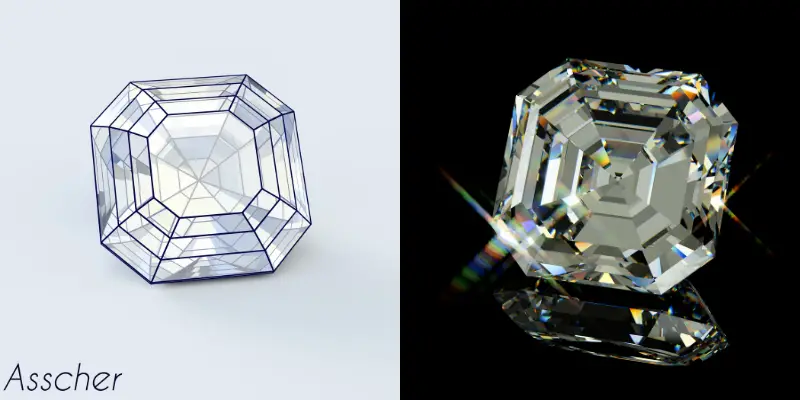
The Asschers in circulation today are a mix of the original Asscher patent, the knock-offs, and the new original Asschers that have been patented again in 2001 as the Royal Asscher cut.
Tips on choosing an Asscher diamond
Not all diamonds are cut the same, and this applies to Asscher cuts as well. These diamonds rely on perfect symmetry, and there are a few things you should keep an eye out for when looking for your perfect Asscher diamond.
Shoulder to culet facets should form a perfect X
There’s significant overlap between a squared emerald cut and an Asscher cut, but there are some subtle yet important differences. One of the biggest things to watch for is the facets leading from the shoulders to the culet. The get gradually smaller, and eventually meet in a single point. It looks very similar to a windmill.
If it’s anything other that a perfect X or windmill, you may want to put the diamond down. Squared emerald cuts have two Vs, connected by a short but noticeable culet (line). Poorly cut Asschers have a different culet, a squared and faceted one. The X doesn’t meet in a point, rather it has a faceted square in the middle.
Those are not real or good Asschers, since they don’t follow the original’s template and because of this they might have light issues. For example the squared culet ones are almost always dead in the center, and the ones that are a squared emerald cut have a ratio that looks off (1.10 usually).
What you’re looking for is a perfectly sharp and closed culet, a single point in the middle of the windmill. Not a line, not a square.
The best Asschers have shoulders almost as large as the sides
There is a symmetry and shape that an Asscher usually follows, and that is the sides are just a bit larger than the shoulders, if not the exact same size. You could say the Asscher is more of an octagonal cut instead of a rectangular or square one.
The size of the shoulders is also the starting size of the facets leading down from the shoulders to the culet. Generally the larger those facets are, the wider the flashes of light and the more sparkle you may get from your Asscher.
When you’re looking at their length to width ratio, you should look for a 1:1 to 1:1.03. The closer to square they are, the better. The way the facets on an Asscher are thought out, they work best when the diamond is in a 1:1 ratio.
Read also: Checkerboard Cut Gems Explained
Always choose high symmetry and polish in Asschers
This is something you should choose in any and all diamonds, but in step cuts like Asscher it’s even more important. Symmetry is how well the facets are aligned, how well they are arranged and reflect off on each other, and in an ‘open’ diamond like the Asscher you will easily notice any symmetry issues.
Polish is one of the most looked-over grades but really it’s just as important as symmetry. A diamond with an Excellent polish grade will allow the maximum amount of light in, and the facets will act like perfectly smooth mirrors. Very good polish also works, but you may see a small difference in light performance between Excellent and Very Good.
Both symmetry and polish grades are present on a diamond report for an Asscher, but there is no cut quality grade. Those only issued for round brilliants, but you can always look at girdle thickness, open/closed culet, table to culet height, and so on. In the end, it’s the diamond in your hand that will make the difference. Always check the diamond in person, under any and every lighting possible.
Do Asscher cut diamonds sparkle ?
Yes, Asscher cut diamonds do sparkle, less than a brilliant cut but more than an emerald cut. Asscher cuts have wide flashes of colored and white light, and they can really sparkle when in direct sunlight and spotlight. Overcast or office lighting will not be amazing on any diamond, of course, but some very good Asschers might throw a bit of fire even in that light.
So if you’re looking for something sparkly and impressive like a round brilliant, an Asscher can’t do that for you. But if you’re looking for a more subdued lightshow with wide flashes of white and rainbow color but more than an emerald cut can offer, then the Asscher is a great choice.
Read also: Do Diamonds Turn Yellow ?
What is the best color and clarity for Asscher diamonds ?
Asscher diamonds are step cut diamonds and allow you to see directly into them, so we recommend you go for a high quality diamond from the start. Don’t try to go lower than an H in color and VVS2 in clarity, because the Asscher will immediately show both the color and inclusions.
An H color will still look pretty white, and if the facets are well cut and polished the brilliance won’t bring back as much yellow. But if you go lower, like an I for example, you might start to see both the body color and a bit of a yellow tint in the broad white flashes within the Asscher. In truth the color is very personal and depends on how warm you’re okay with. We recommend stopping at an H but you do you.
What’s the best setting for an Asscher diamond ?
Asschers look best in simple prong settings, and they’re usually set with 4 prongs, one on each shoulder. Some goldsmiths can prove a double prong setting if you want the look and extra security.
A prong setting will allow as much light as possible into an Asscher diamond and this will help it sparkle. If you’re looking for more security a bezel setting is always a great option, and it could have a milgrain on the edge so it looks a bit more detailed.
We think Asschers work best as solitaires. Adding any sort of side stone at all can ruin the look of perfect symmetry. However you could get baguette pave, if you want something extra while letting the Asscher take center stage.
Are Asscher diamonds expensive ?
Asscher cuts are among the more affordable diamond cuts, compared to round brilliants, ovals, and even emerald cuts. The average price for an Asscher with H color and VVS2 clarity is $4,100 per carat. For comparison the average emerald cut with the same specs is around $5,000 and a round brilliant about $7,800.
So overall you’d get a nice deal with an Asscher. Fairly impressive sparkle, not glittery like a round brilliant but definitely sparkly (more than an emerald cut), and something of a rare diamond if if’s for an engagement ring. One downside is that you have less options for an Asscher, as jewelers carry less of these since the demand isn’t as nigh as it is for say ovals or princes cuts.

I’m the main author for jewelrymaterialguide.com. I started this site after we did tons of research before our wedding and noticed that there is information about rings, jewelry, and so on that is really hard to find on the internet.

